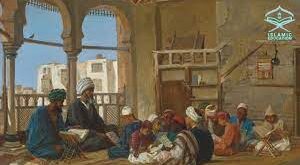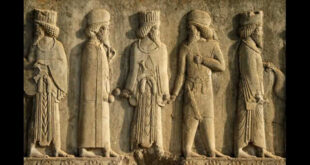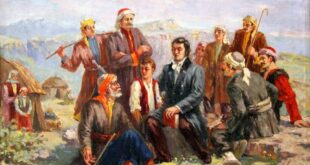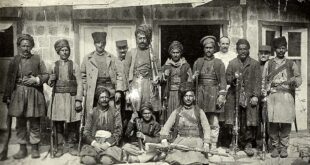The Akkadian Empire
Near the end of the second millennium BCE the king of Akkad, Sargon the Great, had brought all the cities of Sumer under his rule. He had marched his armies into Elam to the east and then west into Syria securing the frontiers for trade and commerce. In some ways Sargon was merely repeating the model laid down centuries before by the nearly mythical Hero-King Gilgamesh. A formula for expanded conquest which had been followed up to the time of Sargon’s one time rival, Lugalzagesi of Uruk. Sargon, however, had a different vision for his territory beyond the submission of neighboring rulers.
The Dynasty of Akkad
Sargon himself reigned for around fifty years and his dynasty ruled supreme for three more generations. This conqueror’s career had such an impact on Mesopotamia that over the centuries his feats became partially mythologized. Sargon’s grandson Naram-Sin would, during his reign, embark on fresh conquests that would lead to even more legendary exploits. There is also considerable evidence that Naram-Sin portrayed himself as a living god. For a century this family would dominate the Near East.
Sargon and Naram-Sin’s conquests have become known as the Akkadian Empire, named after its capital city of Akkad. Many ancient history texts credit the Akkadians with having founded the first empire in history and the martial prowess of its armies are usually given as the reason for its success. Although the Akkadians did have a large and effective military this appears to have been only a tool in the primary effort which was to dominate the known world’s trade routes and through the use of a system of loyal retainers to funnel that wealth into the capital city of Akkad.
In later tradition Naram-Sin is remembered not only for his greatness but for his hubris as well. Indeed one account tells of how Akkad’s prosperity was connected with the temple of Inanna which the goddess herself occupied. With this resident goddess Naram Sin’s city became wealthy and its citizens enjoyed a life of excess. However the legend tells that eventually the King went too far in his grab for power and offended the gods themselves.
The City of Akkad
To understand the real purpose of the Akkadian Empire the extravagance of its capital must be fully appreciated. The city was located somewhere near the Tigris River at the point where the Euphrates draws closest, possibly as far east as Iraq’s Diyala province. Although its exact location remains a mystery there are details in the ancient texts about life in Akkad. Rather than merely an armed camp where Sargon was said to have dined with over 5,000 soldiers daily, Akkad was a cosmopolitan business center and the economic model it fostered would forever alter human history.
When Sargon originally conquered the southern port of Lagash he performed a ritual washing of his weapon in the Persian Gulf. This act was symbolic of Sargon’s control over this waterway. For hundreds of years, since at least the time of the First Dynasty of Ur, goods from as far away as Africa and East Asia had made their way over the sea to Mesopotamia. The actual locations of the ancient lands of Dilmun, Magan and Melluha are open to some debate, yet it is clear that ships from these lands regularly brought goods to the ports of Ur and Lagash. Notably during the time of the Akkadian Empire, these ships docked exclusively up the Tigris river at Akkad. Citizens of the capital city were stationed as governors throughout the empire to monitor this flow of goods.
A close look at the conduct of the Akkadians shows that even their conquests in far flung Anatolia, a source of silver, were focused on securing vital commodities for the citizens of the capital city. For the Akkadians military expeditions were not mere adventurisms. In one account the warehouses of Akkad are said to overflow with wheat, tin, gold, silver, and blocks of lapis lazuli. Foreigners came to marvel at it splendors and even the servants lived lives of relative luxury.
This wealth did come with a price and that is where the Akkadian’s martial skill came into play. Anytime a rival power would challenge the rule of Akkad they would be swiftly destroyed. The ancient accounts record tens of thousands of deaths at the hands of the Akkadian kings. Even with so many foes vanquished in battle the Akkadians still record capturing even larger numbers of prisoners who were then used as slave labor to harvest resources for the imperial city.
Evidence of quarries and mines has been found in the Zagros Mountains that reveal labor camps on a massive scale. Service in one of these camps was likely tantamount to a death sentence. This large scale quarrying effort is possibly alluded to in one of the ancient texts about Sargon where the king challenges any who wish to follow him by saying, “mighty mountains with axes of bronze let him destroy.”
A New World Order
During its peak the Akkadian Empire had managed to consolidate control over trade routes that had already existed for thousands of years but had never before been under such centralized authority. Sargon began the implementation of uniform weights and measures and introduced the Akkadian language as the official written language of the empire. Management of the increasingly vast trade resources necessitated the use of written records and before long even in the remote highlands of the north people were using Akkadian and developing their own scribal traditions. As a consequence the lore of Sumer began to permeate to far flung trade colonies giving much of the Near East a common literary tradition.
Before the Dynasty of Akkad, kings had seen themselves as servants of the gods; they fought wars and conquered on their deity’s behalf. The City-State had held the highest position on the political ladder. These cities, with their temple based commerce and entrenched elite families, had ruled for as long as anyone could remember, that all changed with the Akkadians.
The struggle between warlords/lugals, and priests/ens had shaped much of the dynastic warsduring the third millennium BCE. This struggle faded into the past in a world where kings/šarrum, fought each other for vast empires.
The Akkadian empire would fall apart after a little more than a century and its once prosperous capital of Akkad would be lost to history. Still the impact of the Akkadians has yet to totally fade. Sargon created an ideal of centralized authority based on a commercial empire which was administered by the royal household or palace; this would be the basic model for hundreds of future conquerors.
The Empire After Sargon
The death of Sargon the Great, ca. 2215 BCE, was followed by rebellions across the Akkadian Empire. Sargon’s heir was the younger of his two sons, Rimush. Rimush brutally suppressed the revolts and consolidated his father’s conquests but after less than a decade a coup within the palace deposed the king. Rimush’s older and possibly twin brother, Manishtusu, became king and he was also faced with widespread revolt.
During the early years of the 22nd century BCE the frontiers of the Akkadian Empire were starting to break down. Central Syria was once again under the control of Aleppo and Ebla. Farther to the north a people known as the Hurrians had begun to carve out their own territory. To the east of the Hurrian lands, in what is today northeastern Iraq, the Lullubi tribes had settled into the mountain valleys and effectively stopped the flow of the vital metals trade into the empire from the east. In the central Zagros Mountains, another group of tribes called the Guti, as well as the ancient enemy the Elamites, encroached upon Akkad’s dominion.
A new king assumed the throne of Akkad and was faced with this dilemma, he was the son of Manishtusu, Naram-Sin (recently revised by some scholars as Naram-Suen), a name meaning blessed of the Moon god. The young king quickly took the field in a series of campaigns that rivaled his grandfather’s conquests. Naram-Sin not only secured the frontier of the empire but he also expanded it.
The new King of Akkad followed his grandfather’s claim to the titles, King of the Four Quarters and King of the Universe. To back up such claims he marched his armies up the Euphrates, subdued Mari and defeated the kings of central Syria from Aleppo and Ebla. From here he reestablished control over the Cedar Mountains of Modern Lebanon.
The King of Akkad then again followed his grandfather’s footsteps and moved north to stabilize the trade routes into the silver producing regions of south central Anatolia. Naram-Sin followed up this invasion by building a royal city at Tell Brak, in north eastern Syria. This city allowed the Akkadians to have a permanent presence on the trade routes which crisscrossed the region.
In the south Naram-Sin reaffirmed hegemony over Elam and the ancient oversees trade routes that fed into the Persian Gulf. To secure the southern Zagros he appointed Puzur-Inshushinak as governor of Elam and in an effort to keep the Persian Gulf secure the king personally led an expedition against the rebellious king of Magan which is believed to have been in modern day Oman.
The King Becomes God
Naram-Sin’s most famous battle is the one he waged against the powerful Lullubi tribes. His victory over these people was commemorated by a rock sculpture at Darbabd-i-Gawr in western Iran. After a major military victory the king is portrayed, bow in one hand, arrow in the other, climbing a mountain which was strewn with the corpses of his fallen enemies. In the background Akkadian soldiers move in support of their king. The figure of the king in this sculpture is not only much larger than all the others but he is shown crowned with a horned helm, the symbol of divinity. In the sky above Naram-Sin are stars representing the gods; who have here taken on a supporting role to the king.
Naram-Sin was likely not the first monarch of ancient Iraq to be deified while yet alive and the practice of deifying deceased monarchs was rather common. In the earlier, near mythical accounts of the kings of Uruk, who reigned 500 years before the Dynasty of Akkad, kings such as Lugalbanda and Gilgamesh had achieved divine status. Similar incidents also occurred outside of Sumer’s city states, such as in Egypt where pharaohs beginning with the First Dynasty were routinely deified.
What makes this king different from his deified predecessors in Mesopotamia is the historical records numerous references to his divine status during his reign. There are many accounts of the kings name being unambiguously recorded with a pre-fix dingir in Sumerian or ilu in Akkadian which was hitherto reserved for gods.
How this king came to be deified is unknown. Speculation has ranged from theories that connect divine kingship with the sacred marriage to a goddess (presumably in the guise of a high priestess) to the idea that his subjects chose to deify him as an attempt at flattery. Such theories are very limited in explaining what must have been a very complex series of events.
Naram-Sin ruled for 36 years. Future generations would credit Naram-Sin with greatness that was only equaled by his hubris. Shortly after the king’s death the formally loyal governor of Elam would declare himself ruler of the empire and the final kings of Akkad could do little to stop the chaos which followed.
Shar-Kalli-Sharri
Naram-Sins successor, Shar-Kali-Sharri (2217-2193 BCE), whose name means King of Kings, was immediately beset by treachery and rebellion. Although some accounts portray the new king as holding the empire’s widespread enemies at bay it is clear that the once mighty dominion was reduced to the territory surrounding its capital city Akkad.
The city of Akkad had built itself on wealth gained from the imperial monopoly on trade. Once the king lost control over the region’s various trade routes the city of Akkad itself was doomed. Within the period of just a few generations the city itself vanished from history.
Some accounts indicate Akkad was ultimately destroyed by invading hordes of Gutians from the region of the northern Zagros Mountains. According to the Sumerian King List a new Dynasty from Uruk emerged and defeated the Akkadians. This dynasty was, however, quickly followed by a Dynasty of Gutians. For nearly ten years there was no determinate king of the invading Gutians although their army dominated Sumer and Akkad. During this period of anarchy a few more kings of Akkad are attested and then after the reign of Shu-Turul, around 2154 BCE the Akkadian Dynasty comes to an end.
The Curse Of Akkad
According to one text written some centuries later the city was cursed because Sargon had moved earth from the city of Babylon to lay the foundation at Akkad. This version of events must be dismissed as mere storytelling as the city of Babylon was only a village at the time of Akkad’s founding. Another text, The Cursing of Akkad, explains that it was in fact Naram-Sin who was responsible for invoking the wrath of the gods.
The text relates that for a period of time the goddess Inanna took up residence in the city of Akkad. She had no time to rest as she supervised the luxurious provisioning of the city. All of its citizens were blessed and all of its warehouses were overflowing with tribute from foreign lands. Yet, with all of this wealth diverted to Akkad the city states of Sumer were suffering. In particular, the temple establishment of the chief god Enlil in Nippur known as the, E-kur, denounced Akkad’s rule. What was likely a political rebellion supported by Nippur is portrayed in the ancient texts instead as all of the gods withdrawing their blessings from Akkad. Even Innana who had taken up residence there left the city.
The city began to suffer immediately as its trade revenues dried up. Then the king, Naram-Sin, had a dream that led him to believe that his city’s days were numbered. He tried to divine the future by reading omens and he came to believe that the gods had indeed turned against his city. According to the legend the king took on an austerity plan; he abandoned his robes of state, his royal chariot, and his royal ship for seven years in an attempt to alter the fate of Akkad. However, after his attempts at appeasing the gods the omens offered no comfort so he gave up on a religious solution and resorted to extreme measures.
Naram-Sin sent his army to the E-kur temple where they demolished and looted the sacred building. The wealth of the E-kur was carried back to Akkad and along with it the curse of Enlil. Enlil now inspired the Gutians, described as intelligent but with “canine instincts and monkey features,” to invade. Not only did the Gutians attack Akkad but the region was thrown into such lawlessness that people were “unable to cultivate the fields.”
It is worth noting that paleoclimate records from the region indicate a notable increase in aridity at this time. This raises the possibility that climate change contributed to the collapse of the empire. However it is also possible that what the climate records are showing is the expanse of desertification resulting from an abandonment of large scale irrigation indicated by the statement “unable to cultivate the fields.” If this is the case then the fall of the Akkadian empire before the Gutians was so utter and impactful that its collapse brought about the undoing of what must have been several centuries worth of irrigation efforts.
The legend of the Cursing of Akkad places the invasion of the Gutians as having occurred during the reign of Naram-Sin which is likely not accurate. However the underlying theme of the curse reflects the later belief that King Naram-Sin was responsible for offending the gods and thereby dooming his city. After some decades the other cities of Sumer recovered, but not the city of Akkad. Years later the Third Dynasty of Ur rose to dominate the lands known as Sumer and Akkad, yet the city, which had given name to the region of central Iraq was no more.
Sources
Climate change and the collapse of the Akkadian empire: Evidence from the deep sea
Roux, George, Ancient Iraq, (Penguin Books, London, 1966.)
Saggs, H.W.F. Babylonians, (University of California Press, Berkeley, 2000)
 History of Kurdistan
History of Kurdistan






